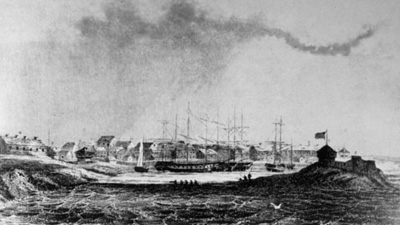Jefferson (1814)
Modeling a War of 1812 Brig – Jefferson (1814)
Ship models are an important tool for testing information derived from archaeological and historical research. After several years, Glenn finished his model of Jefferson, an early 19th century US Navy 20-gun brig in the summer of 2009. Please follow the links to view photographs of the model in progress, and completed.
History
The first decades of the nineteenth century saw great innovations in American shipbuilding. Shipwrights modified hull forms and sailing rigs or developed new types to improve vessel strength and speed. Their work contributed both to the development of naval architecture and to the expansion of American maritime trade. Unfortunately, many key details of the early shipbuilding trade have been lost due to poor record keeping and the perishable nature of wooden hulls. Nautical archaeology has provided the means to retrieve otherwise inaccessible details of wooden vessels, including detailed primary evidence of design and construction practices, as well as information on the living and working conditions of the people who sailed these vessels.
 The greatest shipbuilding race of the War of 1812 took place on the shores of Lake Ontario. Jefferson was built in 1814 at Sackets Harbor in New York by the renowned shipwright Henry Eckford. The vessel was 123 feet long and carried 21 guns.
The greatest shipbuilding race of the War of 1812 took place on the shores of Lake Ontario. Jefferson was built in 1814 at Sackets Harbor in New York by the renowned shipwright Henry Eckford. The vessel was 123 feet long and carried 21 guns.
Henry Eckford, Master Shipwright
Henry Eckford was a respected New York City shipbuilder. Born in Scotland in 1775, Eckford immigrated to Canada at age 16 to learn the trade of ship construction from his uncle, John Black. In 1796, he moved to New York City to work as a shipwright.

Three years later he opened his own yard on the East River. In the years before the war he assembled merchant vessels and occasionally formed partnerships to construct small craft for the United States Navy. In 1808 Eckford and Lester Beebe completed four gunboats for the defense of New York harbor.
In addition to his superior skill in shipbuilding, Eckford was a leader who inspired exceptional dedication from those who worked under his direction. Commodore Isaac Chauncey, speaking of Eckford, stated “there is not his equal in the U. States or perhaps the world.”
Ship Construction at Sackets Harbor during the War of 1812
Like the Brown brothers on Lakes Erie and Champlain, Eckford was required to establish shipbuilding facilities in the wilderness along the shores of Lake Ontario. Most of the necessary labor and materials were imported from the Atlantic coast, resulting in frequent shortages of supplies. Work was carried out in freezing weather under strict construction deadlines. Despite these difficulties, Eckford managed to complete and outfit seven large ships, and was building an eighth, an enormous 110-gun ship of the line, when the war concluded.



Building Jefferson
Eckford began the construction of the brig using the best available wood for shipbuilding: white oak. Softwoods (pine, hemlock and spruce) were used where durability and strength were not as important. The shaping and assembly of the timbers showed considerable care and attention to detail. To speed construction, the ship was built entirely with iron fasteners.
One of the most unique features of the ship is that it was constructed without knees. Knees are naturally curved timbers used to reinforce critical stress points within a vessel. Cutting and fitting them was an extremely laborious and time-consuming task. By constructing the boat without them, Eckford saved weeks of construction time. Instead, a series of diagonal rider timbers were installed between the keelson and the clamp.
The design of Jefferson seems to have been adapted from fast-sailing small-craft types of the period. The overwhelming strength of the Royal Navy led shipwrights to build extremely sharp-hulled vessels with the speed to outrun British ships. The brig Jefferson exhibits characteristics similar to those of a thoroughbred racing horse: capable of a high rate of speed, but demanding constant and very close attention. The ship carried 21 guns weighing a total of 32.2 tons. The combination of the extreme hull form with the weight of the armament would have made the brig ‘crank’, meaning that it was unstable and prone to capsizing. This required vigilance by the crew when the vessel encountered strong gusts of wind.

The Naval Career of Jefferson
By April of 1814, Jefferson was outfitted and rigged in preparation to join the American squadron. Commodore Chauncey assigned Master Commandant Charles G. Ridgely and a crew of 160 men to the ship. After more than three months of waiting, Jefferson was sent up the lake to intercept supplies destined for the British forces fighting along the Niagara River frontier.
At the end of the war, the ship was abandoned at Sackets Harbor.
Archaeological Investigations
Jefferson was relocated in 1984. Approximately forty percent of the original hull was intact, and most of the timbers were well-preserved. The site was the subject of a four-year archaeological study under the direction of Kevin Crisman and Arthur Cohn of the Lake
Champlain Maritime Museum. Key portions of the vessel were systematically excavated, then recorded with measurements, photographs and sketches.

from the wreck of Jefferson.
Despite its broken and battered state, the wreck represents one of the finest examples of early American shipwrightery in existence today. The data collected during the study was used to graphically reconstruct the three-dimensional shape of the hull, as well as its original appearance and internal layout. Details derived from careful recording of the remains of the ship will be used in the construction of this model.
